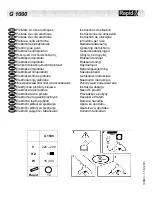
Some environments will require the use
of head protection equipment. When
required, the employer and user must
ensure that head protection is used.
TOOL OPERATION
m
WARNING!
Read all safety warnings and all
instructions. Failure to follow the warnings and
instructions may result in electric shock, fire and/or
serious injury.
1. CHARGING THE BATTERY
Before using the tool, charge the battery as follows:
A.
Insert the charger connecting plug into the
connecting socket of the charger
m
CAUTION
: Do not use the electrical cord if damaged.
Have it repaired immediately.
B.
Insert the battery in the charger (Fig 1)
Position the battery so that the nameplate faces
toward the nameplate of the charger and press in
the battery until it comes into contact with the bottom
plate.
Inserting the battery will turn on the charger and the
indicator light will turn on.
m
CAUTION
: If the indicator light does not come on,
remove the plug from the power socket and check the
battery mounting condition.
The indicator light goes off to show that the battery is
fully charged.
m
CAUTION
: If the battery is heated just after operation
(for example due to direct sunlight), the charger
indicator light may not come on. If this occurs, allow
the battery to cool first and then start charging.
Recharging time: The recharging time required for the
battery supplied with this tool is as follows (approx.
mins at 20°C):
Battery Model:
9R201498
Battery Charger:
9R201515
Battery Voltage:
10.8 V
Battery Capacity:
1.5 Ah
Recharge Time:
45 mins
m
NOTE
: The recharging time may vary according to
the ambient temperature.
C. Hold the charger firmly and pull out the battery
m
NOTE
: Do not store the battery in the charger once
fully charged.
NOTE: ELECTRIC DISCHARGE IN CASE OF NEW
BATTERIES
The internal chemicals of new batteries and batteries
that have not been used for an extended period may not
activated and the electric discharge might be low when
using them for the first few times. This is a temporary
phenomenon, and normal recharging time will be
restored by recharging the batteries 2 or 3 times.
HOW TO MAKE THE BATTERIES PERFORM LONGER.
1.
Recharge the batteries before they become
completely exhausted.
When you feel that the power of the tool is becoming
weaker, stop using the tool and recharge its battery. If
you continue to use the tool and exhaust the electric
current, the battery may be damaged and its life will
become shorter.
2. Avoid recharging at high temperatures.
A rechargeable battery will be hot immediately after
use. If such a battery is recharged immediately, its
chemicals will deteriorate, and the battery life will be
shortened. Leave the battery and recharge it after it has
cooled.
2. PREPARING TO USE THE TOOL
Make sure you have read and understood all the
warnings listed in this manual before proceeding to use
the tool
• When fitting batteries to the tool, the fastener
discharge area of the tool should be pointed away
from the operator and others in the working area.
Place the discharge area of the tool over a test
piece of material of sufficient thickness to fully
accommodate the dimensions of the fastener to
be driven. With hands clear of the trigger and trip
mechanism and with limbs and body clear of the
discharge area, the battery may now be connected.
• Do not pull the trigger or depress the safety trip while
connecting the battery. The tool could cycle, possibly
causing injury.
SAFETY INSTRUCTIONS FOR LOADING
When loading the tool:
1. Never place a hand or any part of the body in fastener
discharge area of the tool;
2. Never point the tool at self or anyone else.
GB











































